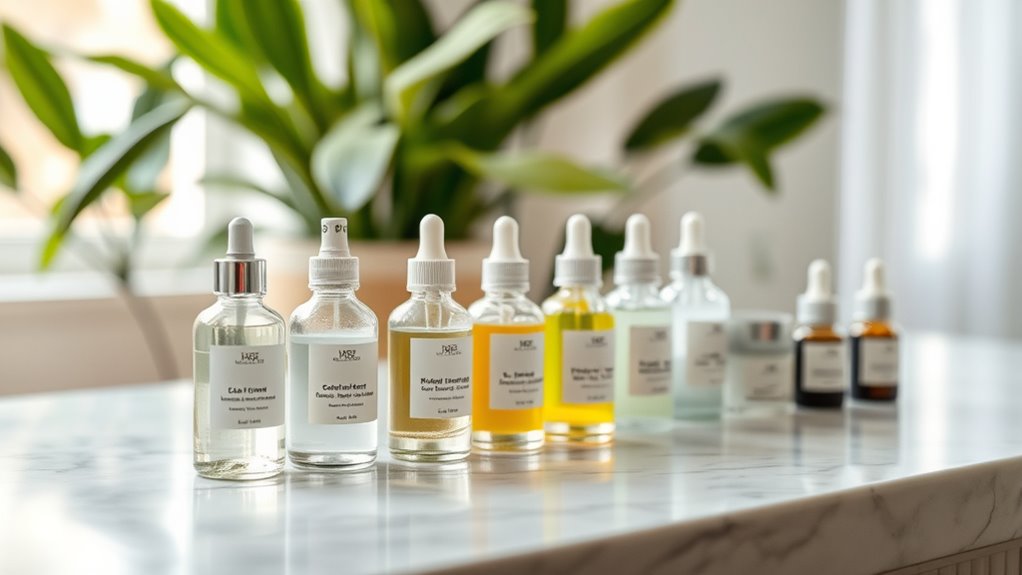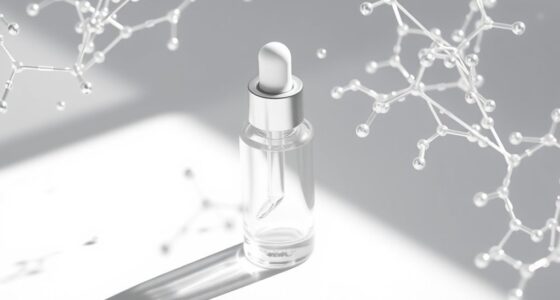Skin cycling is a smart way to boost your skin’s health by alternating active treatments like acids or retinoids with recovery days featuring soothing, barrier-repair products. This weekly rhythm helps prevent overuse, reduces irritation, and strengthens your skin’s resilience. The correct approach varies for everyone, but generally, you might follow a pattern of 2-3 active days followed by 1-2 recovery days. Keep exploring to discover a customized routine that works best for you.
Key Takeaways
- Skin cycling involves alternating active treatment days with recovery days to prevent overuse and support barrier health.
- Typical weekly rhythm includes exfoliation or retinoids on active days, with soothing, barrier-repair products on recovery days.
- Proper formulation selection and sequencing are crucial to minimize irritation and promote skin resilience.
- Consistency and listening to your skin’s response optimize results and prevent setbacks.
- Adjusting the cycle based on seasonal changes can enhance skin’s health and overall appearance.

Have you ever wondered if your skincare routine could be more effective? If so, you’re not alone. Many people are exploring how to optimize their products and routines for better results. One approach gaining popularity is skin cycling—a structured weekly plan that balances active treatments with recovery days. The idea is to prevent overdoing it and to give your skin the time it needs to repair and strengthen itself. But understanding how to properly implement skin cycling requires knowing how different product formulations interact with your skin barrier, which is the foundation of healthy skin.
Your skin barrier acts as a protective shield, keeping harmful elements out and moisture in. When disrupted—by harsh cleansers, aggressive exfoliants, or overuse of active ingredients—it can lead to irritation, sensitivity, and compromised skin health. That’s why choosing the right product formulations is essential. Gentle cleansers, hydrating serums, and barrier-repair creams support the skin’s natural defenses. During your skin cycling routine, you’ll alternate between different types of products—using actives like retinoids or acids on certain days, and then giving your skin a break or using nourishing, barrier-repairing products on others.
Supporting your skin’s defense with gentle, barrier-repairing products is essential during skin cycling.
The key to effective skin cycling is understanding when to apply potent treatments and when to give your skin rest. For example, on “active” days, you might incorporate exfoliants or retinoids to stimulate cell turnover. These formulations are powerful but can weaken your skin barrier if used excessively. That’s why following this with recovery days—using soothing, barrier-repairing products—helps maintain skin health. This approach minimizes irritation and allows your skin to adapt gradually to stronger formulations, reducing the risk of setbacks. Incorporating seasonal variations into your routine can also help optimize your skin’s resilience and response.
Consistency is essential. Sticking to a weekly rhythm allows your skin to build resilience. It’s not about overloading it with actives every day, but rather giving your skin time to recover and strengthen. Over time, you may notice improvements in texture, tone, and clarity. Remember, listening to your skin’s response is fundamental. If you notice redness or irritation, adjust your routine accordingly. The goal is to strengthen your skin barrier, making it more resilient to environmental stressors and improving overall skin health.
In essence, skin cycling isn’t just about using certain products; it’s about creating a balanced rhythm that respects your skin’s natural cycle. By understanding how product formulations affect your skin barrier and tailoring your routine accordingly, you set the stage for healthier, more radiant skin. It’s a simple yet powerful way to optimize your skincare, helping you achieve better results without overstripping or overloading your skin.
Frequently Asked Questions
Can Skin Cycling Improve Specific Skin Concerns Like Acne or Hyperpigmentation?
Skin cycling can help improve concerns like acne or hyperpigmentation by balancing your skin’s recovery and renewal processes. It’s especially effective if hormonal fluctuations cause breakouts or uneven skin tone. By alternating exfoliants and treatments, you reduce the risk of irritation from sun exposure and overuse. This structured routine allows your skin to heal and regenerate, leading to clearer, more even skin over time.
Is Skin Cycling Suitable for Sensitive or Reactive Skin Types?
Think of your skin as a delicate garden needing gentle care. If you have sensitive or reactive skin, skin cycling can be like watering that garden carefully, with a focus on gentle skincare and barrier protection. It allows your skin to rest and recover, reducing irritation. Just remember, start slow and listen to your skin’s signals, adjusting as needed. This approach helps maintain balance and keeps your skin healthy.
How Long Does It Take to See Visible Results From Skin Cycling?
You might start noticing visible improvements from skin cycling within about four to six weeks, but timeframe expectations can vary based on your skin type and concerns. Consistency is key, so stick to your routine and give your skin time to adapt. While some see early changes, true results typically develop gradually, revealing healthier, more balanced skin over time. Patience and persistence will help you achieve the best possible outcome.
Are There Any Risks or Side Effects Associated With Skin Cycling?
You might wonder if skin cycling could cause potential irritation or product sensitivity. While generally safe, overusing potent products or skipping rest days can lead to redness, dryness, or breakouts. To minimize risks, introduce new products gradually and pay attention to your skin’s response. If you notice persistent irritation, reduce application frequency or consult a dermatologist. Listening to your skin helps prevent adverse effects and keeps your routine effective.
Can Skin Cycling Replace Other Skincare Treatments or Routines?
Did you know that 60% of people see improved skin with consistent routines? Skin cycling isn’t meant to replace all your skincare treatments but to enhance routine flexibility. It can boost skincare efficacy by allowing your skin to recover, yet you should still incorporate targeted products for specific concerns. Relying solely on skin cycling might overlook individual needs, so consider it as part of a balanced, personalized routine.
Conclusion
By following the proper skin cycling routine, you’re guiding your skin through a gentle, well-orchestrated dance that promotes renewal and balance. Think of it as giving your skin a well-deserved break before the next performance, ensuring each step builds on the last. When you listen to your skin’s rhythm and stick to a consistent schedule, you’ll see a brighter, healthier glow emerge—like a sunrise after a long night, revealing your most radiant self.










